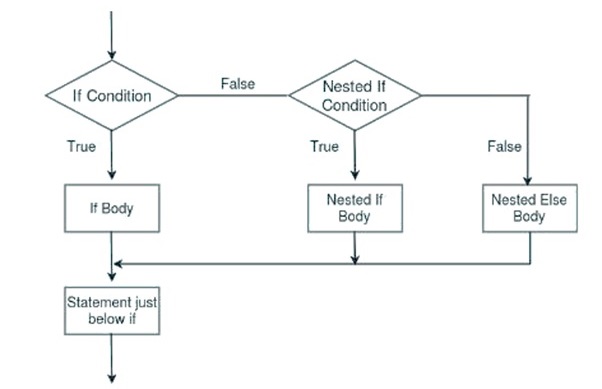It is always legal in C programming to nest if-else statements, which means you can use one if or else-if statement inside another if or else-if statement(s).
In the programming context, the term “nesting” refers to enclosing a particular programming element inside another similar element. For example, nested loops, nested structures, nested conditional statements, etc. If an if statement in C is employed inside another if statement, then we call it as a nested if statement in C.
Syntax
The syntax of nested if statements is as follows −
if(expr1){if(expr2){
block to be executed when
expr1 and expr2 are true
}else{
block to be executed when
expr1 is true but expr2 is false
}}The following flowchart represents the nesting of if statements −

You can compound the Boolean expressions with && or || to get the same effect. However, for more complex algorithms, where there are different combinations of multiple Boolean expressions, it becomes difficult to form the compound conditions. Instead, it is recommended to use nested structures.
Another if statement can appear inside a top-level if block, or its else block, or inside both.
Example 1
Let us take an example, where the program needs to determine if a given number is less than 100, between 100 to 200, or above 200. We can express this logic with the following compound Boolean expression −
#include <stdio.h>intmain(){// local variable definitionint a =274;printf("Value of a is : %d\n", a);if(a <100){printf("Value of a is less than 100\n");}if(a >=100&& a <200){printf("Value of a is between 100 and 200\n");}if(a >=200){printf("Value of a is more than 200\n");}}Output
Run the code and check its output. Here, we have intialized the value of “a” as 274. Change this value and run the code again. If the supplied value is less than 100, then you will get a different output. Similarly, the output will change again if the supplied number is in between 100 and 200.
Value of a is : 274
Value of a is more than 200
Example 2
Now let’s use nested conditions for the same problem. It will make the solution more understandable when we use nested conditions.
First, check if “a >= 100”. Inside the true part of the if statement, check if it is <200 to decide if the number lies between 100-200, or it is >200. If the first condition (a >= 100) is false, it indicates that the number is less than 100.
#include <stdio.h>intmain(){// local variable definition// check with different values 120, 250 and 74int a =120;printf("value of a is : %d\n", a );// check the boolean conditionif(a >=100){// this will check if a is between 100-200if(a <200){// if the condition is true, then print the followingprintf("Value of a is between 100 and 200\n");}else{printf("Value of a is more than 200\n");}}else{// executed if a < 100printf("Value of a is less than 100\n");}return0;}Output
Run the code and check its output. You will get different outputs for different input values of “a” −
Value of a is : 120
Value of a is between 100 and 200
Example 3
The following program uses nested if statements to determine if a number is divisible by 2 and 3, divisible by 2 but not 3, divisible by 3 but not 2, and not divisible by both 2 and 3.
#include <stdio.h>intmain(){int a =15;printf("a: %d\n", a);if(a %2==0){if(a %3==0){printf("Divisible by 2 and 3");}else{printf("Divisible by 2 but not 3");}}else{if(a %3==0){printf("Divisible by 3 but not 2");}else{printf("Not divisible by 2, not divisible by 3");}}return0;}Output
Run the code and check its output −
a: 15
Divisible by 3 but not 2
For different values of “a”, you will get different outputs.
Example 4
Given below is a C program to check if a given year is a leap year or not. Whether the year is a leap year or not is determined by the following rules −
- Is the year divisible by 4?
- If yes, is it a century year (divisible by 100)?
- If yes, is it divisible by 400? If yes, it is a leap year, otherwise not.
- If it is divisible by 4 and not a century year, it is a leap year.
- If it is not divisible by 4, it is not a leap year.
Here is the C code −
#include <stdio.h>intmain(){// Test the program with the values 1900, 2023, 2000, 2012int year =1900;printf("year: %d\n", year);// is divisible by 4?if(year %4==0){// is divisible by 100?if(year %100==0){// is divisible by 400?if(year %400==0){printf("%d is a Leap Year\n", year);}else{printf("%d is not a Leap Year\n", year);}}else{printf("%d is not a Leap Year\n", year);}}else{printf("%d is a Leap Year\n", year);}}Output
Run the code and check its output −
year: 1900
1900 is not a Leap Year
Test the program with different values for the variable “year” such as 1900, 2023, 2000, 2012.
The same result can be achieved by using the compound Boolean expressions instead of nested if statements, as shown below −
If(year %4==0&&(year %400==0|| year %100!=0)){printf("%d is a leap year", year);}else{printf("%d is not a leap year", year);}With nested if statements in C, we can write structured and multi-level decision-making algorithms. They simplify coding the complex discriminatory logical situations. Nesting too makes the program more readable, and easy to understand.
Leave a Reply